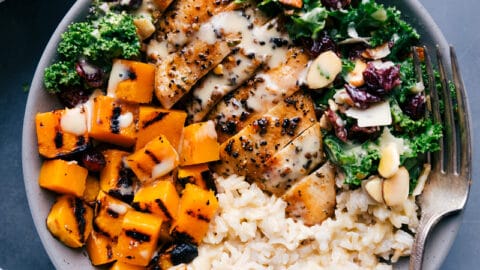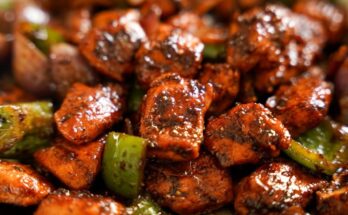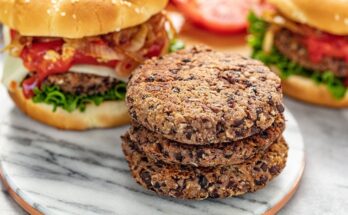Harvest Bowl Recipe: A Harvest Bowl is one of those meals that feels like a hug in a bowl. Imagine a perfectly balanced combination of roasted vegetables, grains, fresh greens, protein, and a flavorful dressing—all brought together in one colorful, nutrient-packed dish. Think of it as the upgraded version of a salad: heartier, more filling, and layered with textures that keep every bite exciting. Unlike a traditional salad, a Harvest Bowl leans heavily on seasonal ingredients like sweet potatoes, Brussels sprouts, and roasted squash, making it a comforting dish during cooler months. However, with a little creativity, it can also be adapted for spring and summer by swapping in lighter produce.
It’s not just about throwing ingredients together—it’s about building layers. First, you start with a base like quinoa, brown rice, or leafy greens. Then, you add roasted or fresh vegetables, followed by your choice of protein such as grilled chicken, chickpeas, or tofu. To finish, you top it all off with crunchy extras like nuts or seeds and drizzle it with a bold, creamy dressing. The result? A balanced, wholesome meal that is both visually appealing and satisfying.
What sets the Harvest Bowl apart is its versatility. You can make it vegan, gluten-free, high-protein, or low-carb depending on your needs. Whether you want something light for lunch or filling for dinner, this bowl adapts beautifully. That’s why it’s become a favorite among meal preppers, busy families, and health enthusiasts.
Why It’s the Perfect Meal for Any Season
At first glance, a Harvest Bowl may seem like a fall-inspired dish (thanks to all the roasted root vegetables), but the truth is, it’s perfect for every season. The idea is to let seasonal produce shine. In fall and winter, you can lean into hearty vegetables like butternut squash, carrots, and roasted beets. These not only bring warmth but also pack in vitamins that support immunity during colder months. In spring and summer, you can lighten things up with cucumbers, cherry tomatoes, corn, and fresh herbs that bring brightness to your bowl.
Another reason Harvest Bowls work year-round is their customizable nature. Have leftover roasted chicken from last night’s dinner? Toss it in. Got an abundance of kale or spinach? Make it your base. Looking for a quick plant-based option? Add lentils or chickpeas. The possibilities are endless, making it one of the most practical yet delicious meals you can prepare.
Beyond seasonality, the Harvest Bowl is also a nutritional powerhouse. It balances complex carbs, lean proteins, healthy fats, and fiber—basically hitting all the marks for a complete meal. Plus, because it’s so colorful, you’re eating a wide range of phytonutrients that contribute to better health. Imagine getting your daily dose of vitamins without feeling like you’re forcing yourself to eat a “healthy” meal—that’s the beauty of it.
Ingredients You’ll Need for the Perfect Harvest Bowl
Base Ingredients
Every great Harvest Bowl starts with a strong foundation, and that means choosing the right base. This is what anchors the dish and provides the bulk of the energy. Here are some tried-and-true options:
- Grains: Quinoa, brown rice, farro, wild rice, or couscous.
- Leafy Greens: Spinach, kale, arugula, or mixed greens.
- Low-Carb Options: Cauliflower rice or zucchini noodles for a lighter bowl.
The beauty here is that you can mix and match. For example, pairing quinoa with kale gives you both the fluffiness of grains and the crunch of fresh greens. If you’re prepping meals for the week, grains like brown rice or farro work best since they hold up well in storage.
Your base sets the tone of the entire bowl. If you want something hearty, go with farro or wild rice. If you’re craving something light, opt for greens. Don’t forget to season your grains with a pinch of salt, herbs, or even a squeeze of lemon juice—it makes a huge difference in flavor.
Protein Choices
A Harvest Bowl isn’t complete without a solid source of protein. This is what turns your bowl from a snack into a satisfying meal. Luckily, you’ve got plenty of options:
- Animal Proteins: Grilled chicken breast, roasted turkey, baked salmon, shrimp, or even steak strips.
- Plant-Based Proteins: Tofu, tempeh, chickpeas, black beans, edamame, or lentils.
- Eggs: A soft-boiled or poached egg adds richness and extra protein.
Protein choices really depend on your dietary preference. If you’re aiming for a classic fall-inspired Harvest Bowl, roasted chicken pairs beautifully with sweet potatoes and Brussels sprouts. For a vegan option, crispy tofu or roasted chickpeas add both crunch and protein power.
The key is to prepare your protein in a way that complements the other flavors. A bit of seasoning—like garlic, smoked paprika, or rosemary—goes a long way. Don’t be afraid to experiment with marinades and spice blends to elevate the overall dish.
Toppings and Garnishes
This is where the magic happens. Toppings are like the accessories of your Harvest Bowl—they bring color, crunch, and bursts of flavor. Some great options include:
- Crunchy Add-Ons: Pumpkin seeds, sunflower seeds, sliced almonds, or walnuts.
- Cheese: Feta, goat cheese, or parmesan for a creamy, tangy bite.
- Fruits: Pomegranate seeds, apple slices, dried cranberries, or roasted pears.
- Extras: Avocado slices, pickled onions, or roasted chickpeas.
The right toppings not only improve texture but also add layers of flavor. For example, adding pomegranate seeds gives you little pops of sweetness that contrast beautifully with savory roasted vegetables. Nuts and seeds provide that satisfying crunch while also packing in healthy fats.
Dressings and Sauces
A Harvest Bowl is only as good as its dressing. The dressing ties everything together, bringing cohesion to the mix of flavors. Some popular options include:
- Tahini Dressing – Creamy, nutty, and slightly tangy.
- Balsamic Vinaigrette – Sweet, tangy, and versatile.
- Maple Dijon Dressing – Sweet from maple syrup, tangy from mustard.
- Green Goddess Sauce – Herb-packed and refreshing.
- Simple Olive Oil + Lemon – For a fresh, clean flavor.
The choice of dressing depends on your bowl’s theme. For a fall-inspired bowl with sweet potatoes and kale, a maple Dijon or balsamic glaze works beautifully. If you’re leaning toward a lighter, summer-friendly version, a lemony tahini or herby green goddess dressing is perfect.
Step-by-Step Guide to Making a Harvest Bowl
Step 1 – Preparing the Base
The first step is cooking your grain or prepping your greens. If you’re using quinoa or brown rice, cook it according to package directions. Be sure to fluff it with a fork and let it cool slightly before building your bowl. If you’re using leafy greens, wash and dry them thoroughly—no one likes soggy greens.
To make your base more flavorful, cook your grains in vegetable or chicken broth instead of water. You can also add aromatics like garlic or bay leaves during cooking. This simple trick turns a plain base into something that enhances the overall flavor profile of your bowl.
When building your bowl, start by spreading the grains or greens evenly at the bottom. This ensures that every bite has a bit of base to balance the toppings.
Step 2 – Cooking or Preparing the Protein
Now that your base is ready, it’s time to focus on the protein. This step is what makes your Harvest Bowl filling and satisfying. Protein provides the energy and nutrients your body needs, so don’t skip it.
If you’re using chicken, season it with olive oil, garlic, smoked paprika, salt, and pepper before roasting or grilling. For salmon, a drizzle of lemon juice and herbs like dill or parsley give it a fresh, vibrant flavor. If you prefer tofu or tempeh, marinate it in soy sauce, maple syrup, and sesame oil before baking—it will caramelize beautifully and give your bowl a savory kick.
Cooking methods matter too. Roasting proteins in the oven creates a caramelized crust that adds depth to the dish, while grilling provides smoky undertones. For a lighter option, steaming or poaching works well, especially if you’re pairing with fresh, raw vegetables.
Once cooked, slice or cube your protein into bite-sized pieces for easy layering. Arrange it neatly over your base—it doesn’t just taste better, it looks more inviting too. Remember, we eat with our eyes first.
Step 3 – Roasting the Vegetables
This is where the Harvest Bowl earns its name. Roasted vegetables are the heart and soul of this dish. They bring warmth, sweetness, and a touch of smokiness that makes each bite feel cozy.
Some of the best vegetables for roasting include:
- Sweet potatoes – naturally sweet and creamy.
- Brussels sprouts – crispy on the outside, tender inside.
- Butternut squash – rich and buttery.
- Carrots – earthy and slightly sweet.
- Beets – vibrant color and earthy flavor.
To roast, cut your veggies into even pieces, drizzle with olive oil, and season generously with salt, pepper, garlic powder, and herbs like rosemary or thyme. Spread them out in a single layer on a baking sheet—overcrowding causes steaming instead of roasting. Bake at 400°F (200°C) for 20–30 minutes, flipping halfway through for even browning.
The result? Golden edges, caramelized flavor, and a tender bite that makes your bowl feel like comfort food in every spoonful. If you’re short on time, you can also sauté vegetables in a skillet for a quicker option.
Step 4 – Adding the Fresh Elements
Balance is key in a Harvest Bowl, and that’s where fresh ingredients come in. They brighten the dish, add crunch, and keep it from feeling too heavy. Imagine pairing warm, roasted sweet potatoes with crisp apple slices—it’s the contrast that makes it memorable.
Fresh ingredients to consider:
- Greens: Spinach, kale, arugula, or romaine for crunch.
- Fruits: Apple slices, pomegranate seeds, grapes, or orange segments.
- Herbs: Fresh parsley, cilantro, dill, or basil.
These elements don’t need much prep—just wash, slice, and sprinkle them in. The key is not to overload the bowl but to add just enough freshness to balance the roasted and cooked components.
Think of the fresh elements as your “finishing touches.” They bring color, brightness, and that refreshing bite that makes your Harvest Bowl complete.
Step 5 – Drizzling with Dressing
Finally, the step that ties everything together: the dressing. Without it, your Harvest Bowl can feel a bit disconnected. With it, you get harmony, depth, and a burst of flavor that elevates the entire meal.
When drizzling, less is often more. Start with a tablespoon or two and toss lightly. You can always add more if needed. If you’re meal prepping, it’s best to keep the dressing in a separate container and drizzle it right before eating to avoid soggy greens or grains.
Some great dressing pairings include:
- Maple Dijon for fall-inspired bowls with sweet potatoes and squash.
- Tahini Lemon for Mediterranean-style bowls.
- Balsamic Glaze for bowls with roasted beets and goat cheese.
- Avocado Lime for a fresh, creamy option.
Remember, the dressing isn’t just an afterthought—it’s the glue that binds the flavors into one delicious bite.
Tips for Customizing Your Harvest Bowl
Seasonal Ingredient Swaps
One of the best things about Harvest Bowls is how adaptable they are to the seasons. In fall and winter, you can lean on root vegetables and squashes. In spring and summer, swap in lighter, fresher options.
- Fall/Winter: Butternut squash, pumpkin, roasted carrots, Brussels sprouts, cranberries.
- Spring: Asparagus, peas, radishes, fresh herbs.
- Summer: Zucchini, corn, cherry tomatoes, cucumbers, stone fruits.
This keeps your Harvest Bowl exciting all year long while also making it more affordable since you’re using what’s in season.
Vegetarian and Vegan Options
If you’re going plant-based, Harvest Bowls are your best friend. Swap out animal protein for:
- Tofu or Tempeh – marinated and baked until golden.
- Legumes – chickpeas, lentils, or black beans.
- Plant-Based Protein Crumbles – for a meaty texture without the meat.
For dairy-free options, replace cheese with nutritional yeast or a dairy-free feta alternative. And when it comes to dressings, go for tahini-based or avocado dressings instead of creamy dairy-based ones.
The end result is just as hearty and flavorful, proving you don’t need meat or cheese to enjoy a satisfying Harvest Bowl.
Protein-Packed Variations
If you’re focused on fitness or need more energy throughout the day, you can easily build a protein-packed version of the Harvest Bowl. Here’s how:
- Use quinoa or farro as your base (both contain protein).
- Add a double serving of chicken, salmon, or tofu.
- Toss in protein-rich toppings like edamame, pumpkin seeds, or hemp hearts.
- Finish with a high-protein dressing like Greek yogurt ranch or hummus-based sauce.
This ensures you’re getting a nutrient-dense meal that supports muscle recovery, keeps you full longer, and fuels your day.
Nutritional Benefits of a Harvest Bowl
Balanced Macros for Energy
One of the best parts about a Harvest Bowl is how naturally balanced it is. You’ve got:
- Carbs from grains and roasted vegetables.
- Protein from animal or plant-based sources.
- Fats from dressings, nuts, seeds, or avocado.
This balance means you’re not just eating a random assortment of foods—you’re fueling your body with everything it needs. Carbs give you quick energy, protein keeps you satisfied, and fats help absorb nutrients while keeping hormones balanced.
Unlike fast food or overly processed meals, a Harvest Bowl is slow-digesting, which means you avoid energy crashes and stay fuller for longer. It’s the perfect choice for lunch, dinner, or even post-workout recovery.
Packed with Fiber and Antioxidants
Another reason Harvest Bowls stand out is their fiber content. Between the whole grains, leafy greens, and roasted vegetables, you’re getting a solid dose of dietary fiber in every serving. Fiber supports digestion, helps regulate blood sugar, and keeps you feeling full longer—something a quick sandwich or fast-food meal just can’t deliver.
Beyond fiber, the rainbow of vegetables and fruits in a Harvest Bowl provides antioxidants. These compounds fight free radicals in the body, supporting better skin, stronger immunity, and long-term health. For example:
- Beets are loaded with betalains, which support liver health.
- Kale and spinach are rich in vitamin C and beta-carotene.
- Pomegranates and cranberries provide anthocyanins that protect against inflammation.
By simply mixing colorful ingredients, you’re not just making your bowl look Instagram-worthy—you’re packing in disease-fighting nutrients with every bite.
Heart-Healthy Fats and Plant-Based Proteins
Harvest Bowls also excel in the healthy fats department. Whether it’s avocado slices, a drizzle of olive oil, or crunchy walnuts, these fats do more than add flavor—they support heart health, brain function, and hormone balance. They also help absorb fat-soluble vitamins (A, D, E, and K) found in leafy greens and roasted vegetables.
For plant-based eaters, Harvest Bowls are a protein goldmine. Chickpeas, lentils, edamame, and quinoa all provide high-quality plant proteins that keep you energized. Pair them with nuts or seeds, and you’ve got a complete protein profile without relying on animal sources.
So, whether you’re aiming for heart health, muscle recovery, or simply feeling satisfied, the mix of healthy fats and plant proteins makes this dish a nutritional winner.
Common Mistakes to Avoid
Overloading with Ingredients
It’s tempting to toss every healthy item you have into your Harvest Bowl, but that often backfires. Instead of a cohesive dish, you end up with a chaotic mix of flavors that don’t complement each other.
A good rule of thumb is to stick to:
- 1 grain or green base
- 2–3 roasted vegetables
- 1 protein source
- 1–2 toppings or garnishes
- 1 dressing
This balance keeps the flavors clean and ensures every bite feels intentional. Remember, less is more—quality beats quantity.
Choosing the Wrong Dressing
The dressing can make or break your Harvest Bowl. A too-heavy sauce can drown out the natural flavors of your veggies, while a weak dressing can leave your bowl tasting flat.
Avoid store-bought dressings loaded with sugar or preservatives—they often mask the freshness of your ingredients. Instead, whip up a simple homemade option. For example, a maple Dijon dressing requires just mustard, maple syrup, olive oil, and apple cider vinegar, yet it tastes gourmet.
Pair the dressing to the season:
- Fall/Winter → Maple Dijon or balsamic glaze.
- Spring/Summer → Lemon-tahini or avocado lime.
This ensures your dressing enhances the ingredients instead of competing with them.
Not Balancing Flavors and Textures
A successful Harvest Bowl is all about balance. If everything in your bowl is soft, it feels one-dimensional. Likewise, if every ingredient is too bold, your taste buds won’t know what to focus on.
Here’s how to build balance:
- Texture → Mix roasted veggies with fresh greens, creamy avocado, and crunchy nuts.
- Flavor → Combine sweet (roasted carrots, apples), savory (chicken, tofu), tangy (goat cheese, vinaigrette), and nutty (pumpkin seeds, tahini).
Think of it as composing a song—you need highs, lows, and rhythms that play well together. When done right, each bite feels exciting rather than repetitive.
Make-Ahead and Storage Tips
Meal Prep for the Week
One of the best things about Harvest Bowls is how meal-prep-friendly they are. You can cook your grains, roast your vegetables, and prep your proteins in bulk, then assemble bowls throughout the week. This not only saves time but also ensures you always have a healthy option ready to go.
To keep things interesting, vary the toppings and dressings each day. For example, use balsamic dressing on Monday, tahini on Wednesday, and avocado-lime on Friday. The base stays the same, but the flavors feel brand new.
Best Containers for Freshness
Storage matters more than people realize. If you just toss everything into one container, you’ll end up with soggy greens and bland textures. The trick is to use divided containers or mason jars:
- Grains and proteins at the bottom.
- Roasted vegetables in the middle.
- Greens and fresh ingredients on top.
- Dressing in a separate container until ready to eat.
This layering keeps everything fresh and crisp, even after a few days in the fridge.
How Long Can a Harvest Bowl Last?
When stored properly, a Harvest Bowl can last up to 4 days in the fridge. The key is keeping wet ingredients separate until serving. If you’re adding avocado, apples, or fresh herbs, wait until the day you plan to eat the bowl—these ingredients don’t store well and will lose their freshness quickly.
For longer storage, you can freeze the grain and protein portions, then add fresh vegetables and toppings when ready to eat. This makes Harvest Bowls a flexible option whether you’re meal prepping for the workweek or stocking your freezer.
Serving Ideas and Pairings
Perfect Beverages to Serve With
To make your Harvest Bowl experience even better, pair it with the right drink. Some refreshing options include:
- Iced Green Tea – light, refreshing, and packed with antioxidants.
- Sparkling Water with Lemon – cleanses the palate between bites.
- Apple Cider (Hot or Cold) – pairs beautifully with fall-inspired bowls.
- Smoothies – for an added boost of fruits and protein.
The beverage choice depends on the mood—something light and refreshing for summer, or something warm and cozy for fall.
Side Dishes to Complement Your Bowl
While a Harvest Bowl is a complete meal on its own, you can serve it with small sides to elevate the dining experience:
- Whole-Grain Bread or Pita – perfect for dipping into extra dressing.
- Soup – a light tomato or butternut squash soup pairs beautifully.
- Fruit Salad – adds natural sweetness to balance savory flavors.
- Roasted Nuts or Snack Mix – keeps the crunch theme going.
These sides aren’t necessary, but they make the meal feel special—like you’re dining at a cozy café instead of just eating a quick homemade dish.
FAQs about Harvest Bowl Recipe
Can I make a Harvest Bowl gluten-free?
Yes! Simply use gluten-free grains like quinoa or rice, and double-check your dressings and toppings for hidden gluten.
What dressing goes best with a Harvest Bowl?
It depends on the season—maple Dijon is great for fall, while lemon-tahini works well in summer. Homemade dressings always taste fresher than store-bought.
Can I serve it warm or cold?
Both work! A warm Harvest Bowl feels cozy and filling, while a cold one is refreshing and perfect for hot weather.
How can I make it kid-friendly?
Keep flavors simple—roasted sweet potatoes, chicken, rice, and a mild dressing usually work best for picky eaters.
What protein works best for meal prep bowls?
Grilled chicken, baked salmon, or roasted chickpeas hold up really well in the fridge and reheat easily without losing flavor.
Conclusion
A Harvest Bowl is more than just a trendy meal—it’s a powerhouse of flavor, nutrition, and creativity. From the hearty base to the roasted vegetables, fresh toppings, and flavorful dressing, every layer is an opportunity to customize and enjoy. Whether you’re making it for a quick weeknight dinner, meal-prepping for the week ahead, or hosting a cozy gathering, the Harvest Bowl always delivers.
It’s simple to make, endlessly versatile, and nourishing in every way. With the right balance of ingredients, you can create a bowl that satisfies cravings, fuels your body, and keeps you coming back for more.



